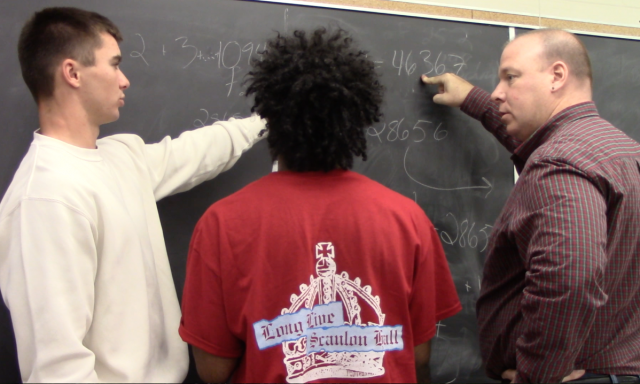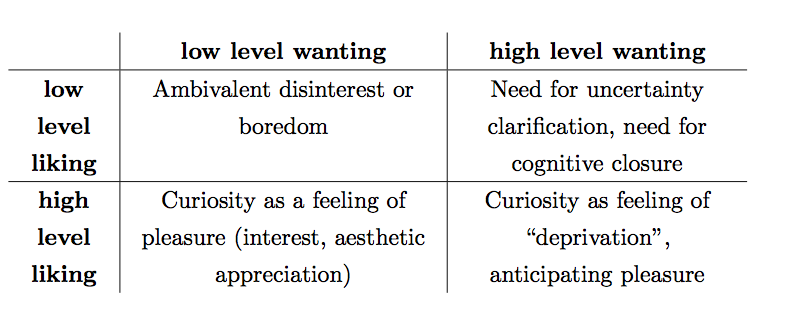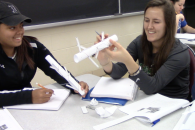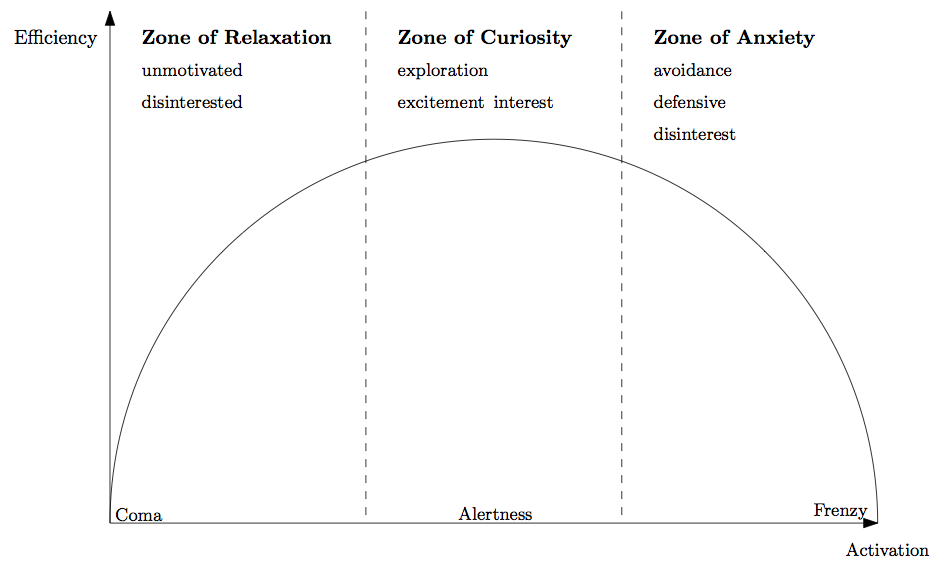Curiosity -- A Culture of Asking Questions
Written by: Dr. Christine von Renesse
"Here in this class you are not told anything, you are expected to use math by diving into the world around you. This leaves all of us sitting here with a million questions which surprisingly enough we answer ourselves by being creative and using our own ideas to understand what we are learning."
DAoM Student, Spring 2015
In my perfect world students would be self-motivated, want to learn, collaborate with other students, ask lots of questions, pursue mathematics outside of class requirements, etc. What then is needed to make this happen? I believe this independent learning I am looking for relies on student curiosity.
Did you notice that curiosity is not an explicit part of most mathematics curricula? For instance, you find no mention of it in the new common core standards. There are some articles about the importance of curiosity for K-12 but I could not find much evidence about the importance of curiosity in higher education mathematics. Yet psychologists found ample evidence that curiosity improves learning. In this blog, and an upcoming paper we are just finishing, we claim that curiosity and inquiry are essential for learning mathematics and that college students can nurture their curiosity and their ability to ask (mathematical) questions if they are immersed in a culture of asking questions which includes:
- Inquiry materials that ask questions
- Class discussions based on asking questions
- Facilitator asking questions to support groups
- Cool things that make students wonder about the world
- Student projects based on questions about mathematics and connections
Staging a Disagreement
In the following video clip you can join my multivariable calculus class. The students have reinvented the definition of directional derivative in their groups and now compare their different definitions in a whole class discussion. Trying to resolve the disagreement creates energy and curiosity in the classroom.
I like the energy in the classroom to be high and positive and for this my students need to be curious and engaged. So, what is curiosity and how do students become more curious? The debate about curiosity -- its definition, how it gets activated and what exactly it does -- seems to be ongoing in psychology (see references at the end). My goal for this blog is to make you, the reader, curious about curiosity.
George Loewenstein proposes in his paper "The Psychology of Curiosity: A Review and Reinterpretation" that a knowledge-gap produces a feeling of deprivation, which he calls curiosity. Curiosity is the complex feeling and cognition accompanying the desire to learn what is unknown. He argues that the following factors will lead to the noticing of a knowledge-gap and hence curiosity:
- The posing of a question, riddle or puzzle
- Exposure to a sequence of events with an anticipated but unknown result
- The violation of expectations (something seems contradictory)
- Possession of knowledge by someone else
- Past knowledge that is now “just out of reach”
In the above video clip many of Loewenstein’s points could be seen in action. I posed a question that the students anticipated a result to, the discussion lead to contradictory conjectures and student groups possessed different knowledge. Loewenstein explains that a knowledge base is necessary and that the knowledge-gap has to be manageable to stimulate curiosity. To have all students engaged in the class discussion everyone needed to have wrestled with the definition for a while themselves.
In a later paper Kang et all showed in experiments that a higher level of curiosity had a strong effect on remembering the information. If you let students pursue what they are curious about (or set it up so that they feel curious about what you would like them to learn) they have a better chance of remembering the content. This is clearly contrary to the common belief that the only way to remember something is through mindless repetition. Additionally Mullaney et all showed in experiments that delayed feedback to guessing will enhance long-term memory if the subjects were curious about the answer. Their result seems to support that students recall content better if we let them struggle to find their own answers without us giving immediate feedback.
I often use the phrase "I am wondering..." and my students take on my language after a while themselves. It is beautiful to observe the students in non-judgmental mathematical conversations -- mostly expressing interest and curiosity in the other person's thinking instead of trying "to be right". I do not answer student questions directly. Instead I ask a question back that hopefully helps the student in refocusing their thinking. I like to "stage disagreements" and facilitate non-judgmental discourse in my classes to raise the energy level but there are more ways to make students curious. Please join me in visiting another classroom:
Cool Things and Curiosity
In the following video you can witness a student that became curious after a "cool thing" : I told her of a paper about the mathematics of finger printing that I had just read.
Thanks to Julian, I have a list of "cool things" that I want to show my class over the course of a semester. The curiosity or energy that can arise from absorbing "cool things" is clearly different from the staged disagreements and discourse in the first vignette. Building on Loewenstein's work, J. A. Litman describes in his paper "Curiosity and the pleasures of learning: Wanting and liking new information" a model that explains different kinds of curiosities. He refers to wanting and liking as biologically different processes in the brain -- resulting in dopamine activation or opioid activity, respectively. Related to curiosity, wanting means that there is an uncertainty that needs to resolved, liking means that learning something new is pleasurable. Both aspects trigger a reward system in the brain.
In the context of Litman’s table, "cool things" produce a higher level of liking while a staged disagreement induces a higher level of wanting. We can use either one to increase the energy in the classroom and ``make'' the students more curious. And students take the curiosity with them when they leave the class as you can see form the following student quote:
"I think this class is making me more curious overall. Before this class I seldom looked at the 3-dimensional world we live in and thought 'hmm, I wonder how those parts fit together'?"
DAoM Student, Spring 2015
What's in the Way?
Some of the emotions that can get in the way of inquiring and asking questions are fear and shame. We are part of a culture of knowing and it doesn't feel good to admit that we struggle or don't know. In fact, we often connect not knowing with being stupid. This doesn't need to be the case. Psychologist Prof. J. Stigler at UCLA reports in an interview with NPR that in Asian cultures struggle is seen as an opportunity, not a weakness or inability.
Shame of not knowing and fear of ridicule can get in the way of even wanting to wonder and hence of asking questions. Celebrating mistakes and creating a safe space for struggle helps students to leave the zone of anxiety. According to H.I. Day, Berlyne’s theory of curiosity describes three zones: relaxation, curiosity and anxiety. Day claims that a student learns most efficiently in the zone of curiosity. In this context, "cool things" can bring students from a zone of relaxation into the zone of curiosity. Lively discussions and inquiry can keep students in a curious state. Especially in the beginning of the semester it is important to get students out of the zone of anxiety. To accomplish this I like to use autobiographies, readings like "A Mathematician's Lament" and fairly easy and engaging first activities.
"We were never told the cookie cutter way of finding an answer. We struggled, using trial and error and our own thoughts to find the answer to the problem. Yes, it was insanely frustrating. I cannot tell you how many times I wanted to throw my notebook out the window, or at my teacher (sorry Professor, it’s the truth). However, when I finally figured out the answer to the problem, I have never felt smarter. Here I was in math class, a subject I feared my entire life, feeling invincible. That’s right, invincible. For the first time in my life, I felt like I was fighting for my education. That is how you feel when you’re really learning."
DAoM Student
See also our paper in PRIMUS .
References
Day, H I. Curiosity and the Interested Explorer. Performance and Instruction. 21.4 (1982): 19-22.
Kang, M.J. et a., The Wick in the Candle of Learning: Epistemic Curiosity Activates Reward Circuitry and Enhances Memory. Psychological Science. 20.8 (2009): 963-73.
Knuth, E. J. Fostering Mathematical Curiosity. The Mathematics Teacher 95.2 (2002): 126-30.
Litman, J. Curiosity and the Pleasures of Learning: Wanting and Liking New Information. Cognition & Emotion. 19.6 (2005): 793-814.
Loewenstein, G. The Psychology of Curiosity. Psychological Bulletin, Vol 116, No. 1. 75-98. (1994)
Mullaney K. M. et a. . Waiting for feedback helps if you want to know the answer: the role of curiosity in the delay-of-feedback benefit. Memory & Cognition. 42 (2014): 1273-84.
Shonstrom, E. How Can We Foster Curiosity in the Classroom? Commentary in Education Week, published in print: June 4, 2014. Online








